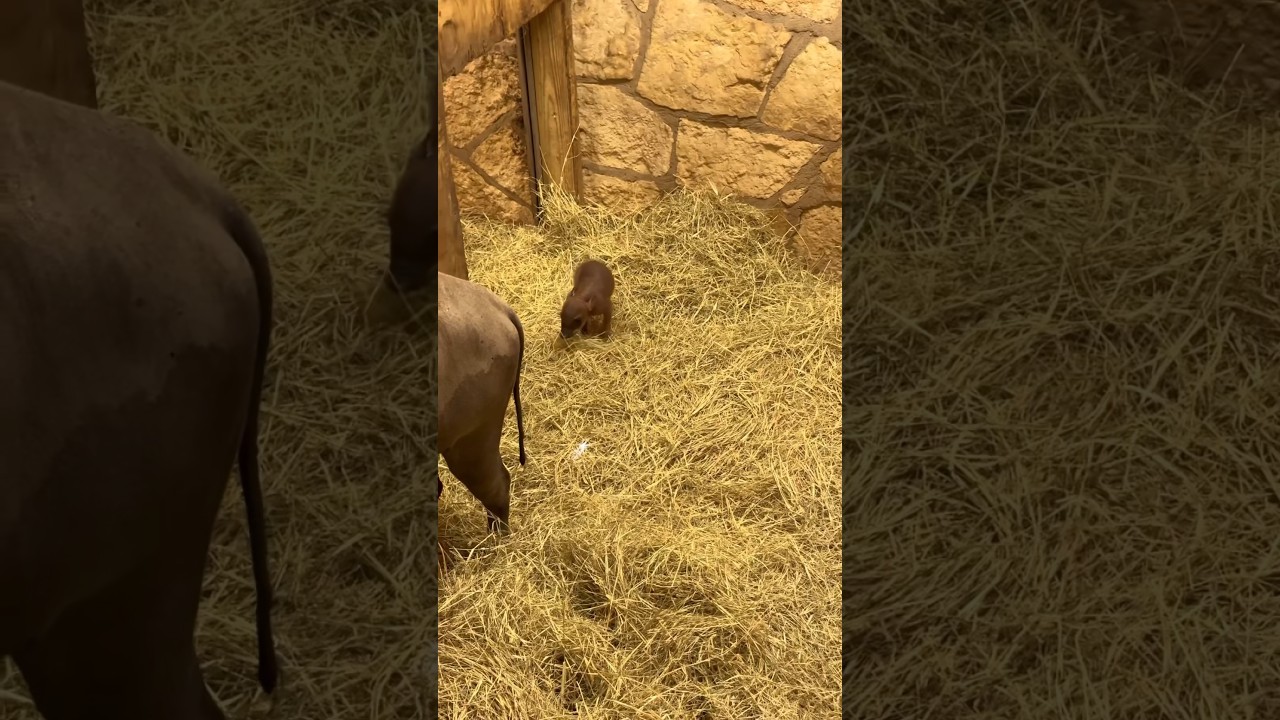– Experience the charm of the San Antonio Zoo’s newest addition: the baby babirusa.
– Discover what makes babirusas unique among their hooved kin.
– Learn fun facts about babirusa biology and their peculiar upturned tusks.
Huddle close, animal lovers, and hear the tale of the cutest newcomer in town: the baby babirusa at the San Antonio Zoo. This little porker, not to be confused with your garden variety pig, is a spectacle of nature not many get to witness up close.
Have you ever laid eyes on a babirusa? If not, imagine a swine with a prehistoric twist. Originating from the lush forests of the Indonesian islands, the babirusa stands apart in the family Suidae. These aren’t your everyday farmyard pigs; they’re a different breed of forest-dwelling charmers.
At first glance, the baby babirusa captures hearts with its soft, mottled brown coat that seamlessly blends into its environment’s foliage. These creatures are nature’s little paradoxes—seemingly gentle and docile yet built for the rigors of the wild.
Babirusas are voyagers, and our little zoo resident is no exception. In the wild, they would tread through dense brush and wallow in the mud-bathed marshes. Understanding their foraging behavior gives us a profound appreciation of their place in the ecosystem. They are the true cultivators of their habitat, turning over soil and dispersing seeds, all while searching for a delectable feast of roots, fruits, and leaves.
While their diet in the wild is varied, here at the San Antonio Zoo, our baby babirusa relishes a carefully curated menu designed to meet all its nutritional needs without stinting on variety. The staff ensures that the diet stimulates not just this bright-eyed creature’s belly but the intellect.
Have you heard of the enigmatic spiraling tusks that captivate adult babirusas? These tusks defy gravity and convention by curling back towards the babirusa’s forehead. However, our little one has yet to sprout such remarkable appendages. It’s common for male babirusas to develop iconic upper canines that penetrate the skin and curve back towards their heads, whereas females tend to have smaller, more subdued tusks or none.
But hold onto your hats, for here’s a whirlwind of a fact—the tusks serve no clear purpose! They’re not typically used for digging or combat, as one might assume. Instead, they’re considered an oddball quirk of evolution, a fascinating feature without a clear function. Regardless of whether tusks develop, the creature symbolizes nature’s whimsical side as our baby babirusa grows.
Parenting in the Babirusa world is an endeavor that would fascinate any passionate observer of wildlife. In the protective expanse of their habitat, baby babirusas stay close to their mothers, who are exemplary in their maternal duties. The bond is a tender spectacle—full of nudges and nuzzles—demonstrating the enfolding significance of family within many animal societies. Here at the zoo, the keepers step in only when necessity demands, allowing for as natural an upbringing as can be afforded in this safeguarded environment.
While the baby’s care is strongly maternal, the same gentleness does not extend among the males of the species, particularly in the wild. Babirusa males are notorious for their dramatic, though rarely dangerous, clashes where their tusks clash in testament to their might. But those tusks are brittle, making these powerplays more about the show than actual combat efficiency.
Enough about tusks; let’s talk about the intelligent sparkle in the eyes of our young babirusa—this is not a boarish gaze but one of curiosity and cognition. These are social beings, after all. They communicate with a vocabulary of grunts and squeals and perhaps a few utterances we have yet to decipher. Their social sophistication is on full display for those who take the time to observe.
Zoo life for this youngster involves an enchanted combo of play, rest, and exploration. Every day is a new chapter of learning. Our growing babirusa practices the art of being a pig and wild at heart under the tender observance of the zoo staff and the delighted public.
The conservation status of babirusas is a sobering interlude to their enchanting narrative. Categorized as vulnerable, these captivating creatures face threats from deforestation and hunting in their native homes. Thus, our baby babirusa is an ambassador, a charming furry diplomat highlighting the desperate need for conservation efforts.
Seeing the baby babirusa thriving under the dedicated care at the San Antonio Zoo is both a beacon of hope and a call to action. Do you wish to contribute to the noble cause of preserving these bewitching beasts? Support the zoo, engage with conservation organizations, reduce, reuse, recycle, and opt for sustainable products that safeguard forest habitats.
Let’s not forget the pleasant moments of whimsy our baby babirusa brings into our lives. A visit to the zoo teases the imagination with wonders. It brings smiles with the simple pleasures of witnessing such a rare creature frolic and adapts to its lovingly recreated habitat.
As our small protagonist jaunts through playtime and mealtime, the baby babirusa does more than exist—it thrives, animates the heart, and without uttering a single word, it teaches us about the splendid diversity of life on earth. Ponder their existence, delight in their peculiar charm, and may the enchantment of their presence fill you with warmth just as the San Antonio sun caresses their bristled skin.
In closing, take a chance to witness the magic. When you set foot in the San Antonio Zoo, you step into a world of wonder, earnest guardianship, and, most importantly, a home where every creature has a tale to be told and a life to be cherished. Our baby babirusa is one animal among many, each with a unique story that whispers the larger narrative of our planet’s extraordinary tapestry of life.
*****
Source Description


